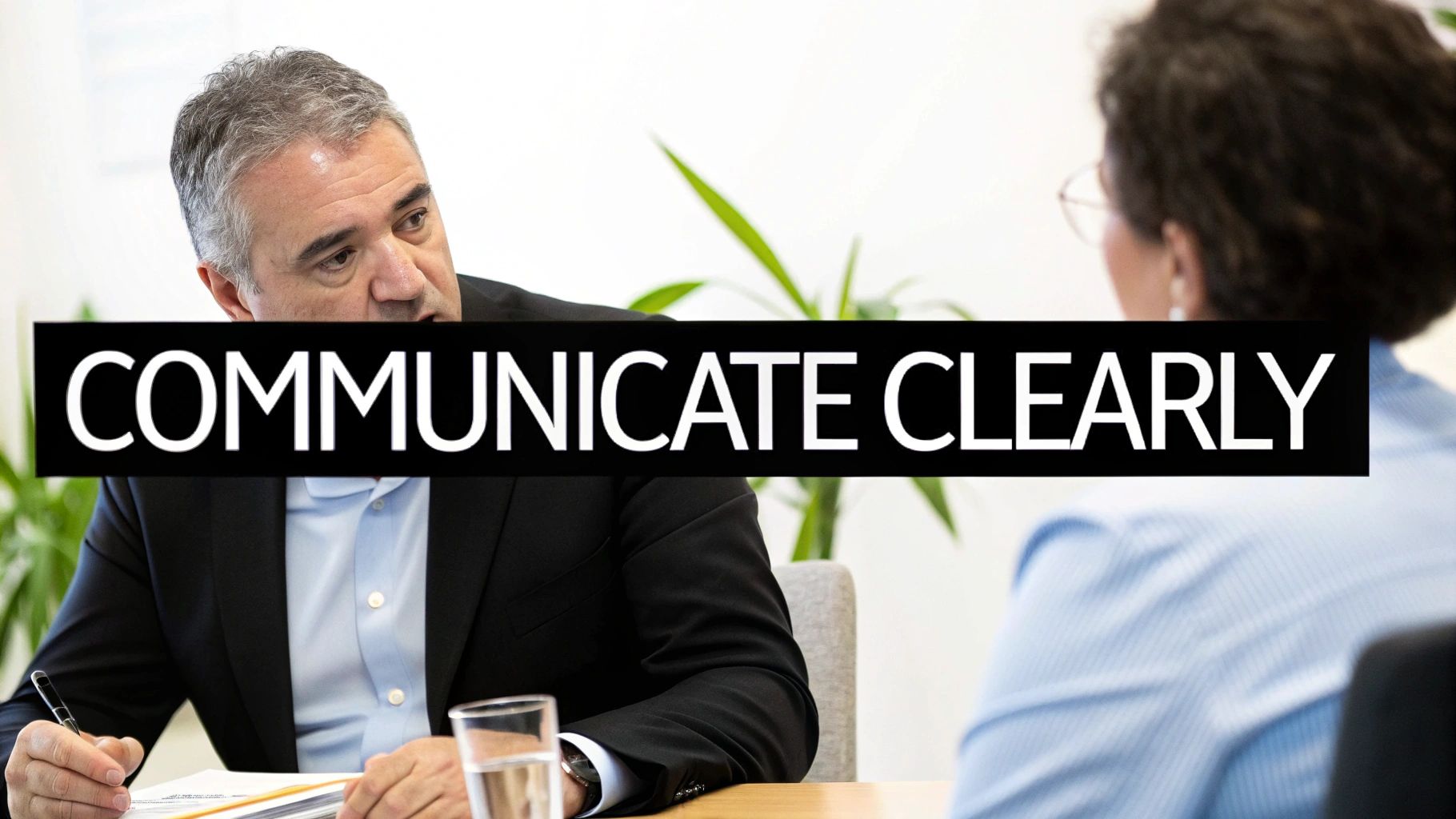
Executive presence used to be all about boardrooms and industry events. But the digital age has changed how we see and evaluate leaders. Personal branding for executives is now essential, a core business function. It's about strategically shaping your public image to strengthen leadership, build trust, and drive business results.
Traditional networking is still important, but its scope is limited. Today, your online presence is your first impression. This digital footprint affects not only your personal reputation, but also how people view your organization. A strong executive brand enhances credibility, builds trust with stakeholders, and positions your company as an industry leader.
Imagine a CEO actively sharing insightful content on LinkedIn. This can draw in top talent, potential investors, and future clients.
The idea of personal branding has come a long way since Tom Peters' 1997 Fast Company article, The Brand Called You. Google searches for "personal brand" have increased fourfold in recent years. Executives understand that a solid personal brand improves visibility and credibility, which creates more business opportunities. In fact, 82% of people are more likely to trust a company whose leaders are active on social media. This highlights how personal branding shapes consumer behavior and builds trust. Find more detailed statistics here.
Effective personal branding helps executives and their organizations stand out in a crowded market. It acts like a magnet, attracting opportunities that might otherwise be missed. A well-defined personal brand helps executives:
Attract Top Talent: Showcasing leadership style and company culture helps attract skilled individuals who share your vision.
Secure Strategic Partnerships: A strong personal brand can open doors to valuable collaborations that boost business growth.
Influence Industry Narratives: Executives with a strong online presence can shape conversations and become thought leaders.
The benefits of personal branding are clear, but measuring ROI is critical. This means looking beyond vanity metrics like follower counts. Instead, focus on real results like:
Increased Speaking Engagements: Has your increased visibility led to more speaking opportunities at important events?
Media Mentions and Features: Has your personal brand generated positive media coverage for you and your organization?
Improved Employee Engagement: Are employees more engaged with your content and company initiatives?
New Business Development Leads: Can you link new, qualified leads to your personal branding efforts?
Tracking these key performance indicators (KPIs) shows the real value of investing in your executive personal brand. Seeing personal branding as a business strategy, not self-promotion, is what sets apart today's effective leaders. This approach positions executives as powerful brand ambassadors for their organizations.
Before diving into the specific tactics of personal branding for executives, it's essential to build a robust strategic foundation. This foundation serves as your roadmap, aligning your efforts with your goals and creating a distinct presence in the competitive market. This begins with a deep understanding of yourself as a leader and your aspirations.
The first step is understanding your current position. This is a personal brand audit, an honest assessment of how you're perceived by peers, colleagues, clients, and the broader industry. It helps identify strengths to capitalize on and any weaknesses to address. Are you known for your innovative ideas, strategic thinking, or mentorship skills? Pinpointing these attributes provides the foundation for your brand narrative. For a more detailed look at honing your business acumen, check out this helpful article: How to master your business intellect. A thorough audit sets the stage for a brand that accurately reflects your value.
After understanding your current perception, the next step is defining your unique leadership voice. This means identifying the values, perspectives, and experiences that shape your leadership style. It's your distinct viewpoint on your industry and the world. This goes beyond mere communication style; it's about the substance of your message – what you represent and your unique contributions. A clear leadership voice ensures your message resonates authentically, distinguishing you from other leaders. This differentiation is key to building a memorable and impactful brand.
An effective executive brand seamlessly integrates personal aspirations with organizational goals. This alignment creates synergy, amplifying your influence. For example, if your company prioritizes sustainability and you personally champion environmental causes, this shared focus builds a powerful and authentic story. This strengthens both your brand and the organization's image, guiding your platform and content choices toward consistent messaging.
At the heart of executive branding is communicating your professional journey and value proposition clearly and compellingly. For those interested in further exploration, see: How to master… This narrative should resonate with key stakeholders while remaining true to yourself. It’s the story of your career, highlighting achievements, challenges overcome, and lessons learned. It adds context and depth to your brand, making it relatable and engaging. A well-crafted narrative is the cornerstone of your brand, shaping how others perceive you and your contributions.
To further help executives evaluate their personal brand, the following framework can be used:
The "Personal Brand Element Assessment Framework" below provides a structured approach for executives to evaluate and develop key components of their personal brand. It encourages a strategic approach to brand building by considering both the importance of each element and how quickly it needs to be addressed.
| Brand Element | Assessment Questions | Strategic Importance | Implementation Priority |
|---|---|---|---|
| Leadership Voice | What are my core values? How do I communicate my vision? What makes my perspective unique? | High | High |
| Professional Narrative | What is the story of my career journey? What are my key accomplishments and challenges overcome? How do I articulate my value proposition? | High | Medium |
| Personal Platform | Which platforms align with my target audience? How can I ensure consistent messaging across channels? How does my personal platform support organizational goals? | Medium | Medium |
| Network and Relationships | Who are my key stakeholders? How do I nurture and expand my network? How can I leverage relationships to enhance my brand? | Medium | Low |
| Online Presence | Is my online presence consistent with my brand narrative? How can I optimize my online profiles to enhance visibility? How do I manage my online reputation? | High | High |
This framework helps executives prioritize their personal branding efforts. By considering both strategic importance and implementation priority, they can create a roadmap for developing a strong and impactful personal brand. A consistent and authentic personal brand, aligned with both individual and organizational goals, is essential for effective leadership in today's business environment.

Building a solid executive brand foundation is essential. But strategically using digital platforms amplifies your message and broadens your reach. This requires understanding each platform's strengths and tailoring content accordingly. Let's explore how to use LinkedIn, Twitter, and other channels to establish a powerful online presence.
LinkedIn is arguably the most crucial platform for executive personal branding. It's your digital resume, networking hub, and content distribution channel all in one. A well-optimized profile is fundamental.
This includes a professional headshot, a compelling headline showcasing your expertise, and a detailed summary highlighting your accomplishments. But a complete profile is just the starting point. Regularly sharing industry insights positions you as a thought leader.
Engaging in discussions and groups expands your network. Consistent activity builds credibility and establishes you as an industry voice. For a deeper dive, check out our guide on how to master LinkedIn for personal branding.
LinkedIn excels at professional networking. Twitter, however, is built for real-time engagement and thought leadership. Share quick insights, comment on trends, and participate in broader discussions. For executives, Twitter provides an avenue to show personality while remaining professional.
This balance is key to strong personal branding on the platform. Using relevant hashtags increases tweet visibility and connects you with people interested in your area. By carefully curating your Twitter feed, you can become a go-to source for industry information.
Beyond social media, contributing to industry publications and speaking at events enhances your executive presence. Publishing articles in respected journals establishes you as an expert. It greatly expands your reach. These publications become valuable content to share on social media, boosting credibility.
Speaking engagements let you share insights with a live audience. This demonstrates your expertise and builds personal connections. These often lead to more networking and media opportunities, increasing visibility. Blending online and offline activities creates a synergistic effect, maximizing your impact.
A content calendar is vital for consistent online presence. Plan and schedule posts to ensure messaging aligns with your branding. This consistency engages your audience and reinforces key messages. But creating content isn't enough.
Measure your efforts' impact. Look beyond vanity metrics like follower count. Focus on key performance indicators (KPIs) like website traffic, lead generation, and brand mentions. Tracking these KPIs helps you assess your strategy's effectiveness and adjust for maximum ROI. This data-driven approach aligns your activities with business goals. Consider exploring: How to master social media branding.
Personal branding is crucial for executive sales and marketing. Leads from employee social media convert seven times more than other leads. Sales reps using social media outperform 78% of their peers. Personal branding builds connections that boost sales. 84% of C-level and VP-level buyers use social media when making purchasing decisions, making a strong online presence essential. Learn more here.
Authenticity forms the foundation of effective personal branding for executives. It involves projecting a genuine image that connects with your audience, building trust, and fostering stronger relationships. This requires carefully balancing vulnerability and maintaining a professional demeanor. Sharing your career path and core values in an honest way can establish you as a relatable and trustworthy leader. Learn more about authentic leadership at How to master authentic leadership presence.
Authenticity doesn't require revealing every personal detail. It involves selectively sharing experiences that highlight your values and have shaped your leadership style. This vulnerability, when presented thoughtfully, can forge a powerful human connection.
Discussing past challenges and the lessons you’ve learned demonstrates resilience and offers your audience valuable takeaways. However, maintaining professionalism remains crucial. Oversharing can diminish credibility. Consider what's truly relevant to your professional brand and maintain appropriate boundaries.
Authenticity is amplified by genuine storytelling. Sharing your professional journey—your motivations, obstacles, and successes—creates a narrative that resonates with people. This makes you more relatable and memorable.
Consider this: would you trust a leader who seems flawless, or one who has overcome adversity and grown from it? Authenticity isn't about perfection; it's about genuine human connection. This connection fosters trust, the bedrock of any strong personal brand.
Personal branding significantly influences customer loyalty and retention. Studies reveal customers with a personal connection to a brand representative have a 60% to 70% higher likelihood of making repeat purchases. Furthermore, 92% of people trust recommendations from individuals over brands, highlighting the importance of personal connections. Explore this topic further.
While vulnerability is central to authentic branding, setting clear boundaries is equally vital. Think of your personal brand as a glimpse into your professional life, not your entire personal life.
Carefully consider which aspects of your experience are relevant to your leadership and message. Make informed choices about what to share publicly and what to keep private. This safeguards your credibility while still allowing for meaningful engagement. Sharing insights into your team-building approach is relevant; discussing personal family matters is generally not. These choices shape a professional and trustworthy public image.
Consistency between your public image and your internal leadership style is essential for trust-building. If your public persona doesn't match your actions within your organization, it can create a perception of inauthenticity. This disconnect can erode trust and harm your credibility.
Promoting a collaborative leadership style online while operating autocratically within your company creates a noticeable discrepancy. Strive for coherence. Your online presence should accurately reflect the values and behaviors you embody as a leader. This alignment strengthens your brand's authenticity and resonates more profoundly with your audience, reinforcing trust and showcasing integrity. This cohesive approach cultivates a trustworthy executive presence.

Effective executive personal branding is more than just cultivating a positive reputation. It's a strategic tool for achieving measurable business outcomes. Modern leaders are using their personal platforms to drive organizational success, impacting areas from recruitment to strategic alliances. This approach recognizes the individual leader as a key catalyst for business growth.
Demonstrating the return on investment (ROI) of personal branding initiatives is crucial for securing buy-in and justifying continued investment. This requires shifting away from vanity metrics like follower counts and focusing on quantifiable results tied to business objectives.
For example, tracking an increase in speaking engagements at prestigious industry conferences demonstrates growing influence and thought leadership. Media mentions in reputable publications, like Forbes, showcase expertise and enhance brand visibility. These are tangible examples of how personal branding translates into real business value.
Furthermore, measuring internal employee engagement with executive content reveals the impact of branding within the organization. Increased employee participation in company initiatives and a reinforced sense of shared vision are valuable internal outcomes. Tracking new business leads stemming from personal branding activities provides a clear link between individual efforts and organizational growth. This data-driven approach solidifies personal branding as a viable business strategy.
Let's explore the tangible business benefits derived from strategic executive personal branding efforts in the table below.
The following table illustrates the impact of executive personal branding across various business functions. It outlines the mechanisms through which this impact is achieved, the metrics used to measure success, and provides real-world examples.
| Business Function | Impact Mechanisms | Measurement Metrics | Success Examples |
|---|---|---|---|
| Talent Acquisition | Enhanced employer brand, attracting top talent | Inbound recruitment inquiries, quality of applicants | Increase in applications from top-tier candidates due to CEO's LinkedIn presence |
| Strategic Partnerships | Building relationships with key influencers | Number of new partnerships, value of partnerships | New market opportunities secured through relationships fostered on Twitter |
| Brand Visibility | Media mentions, speaking engagements | Media mentions in target publications, speaking invitations | Increased brand awareness and positive media coverage |
| Sales and Marketing | Lead generation, increased brand trust | Number of leads generated, conversion rates | New business opportunities originating from personal branding activities |
| Employee Engagement | Reinforcing company culture, shared vision | Employee participation in initiatives, internal surveys | Increased participation in company programs due to executive visibility |
As shown in the table, a strong personal brand can positively influence numerous business functions. By focusing on measurable results and aligning efforts with corporate objectives, executives can effectively leverage personal branding as a powerful business growth tool.
Creating synergy between personal and corporate messaging is essential for maximizing impact. This alignment reinforces key messages and avoids conflicting narratives, strengthening both the individual and organizational brand.
A well-aligned personal brand complements and amplifies corporate messaging, creating a unified and powerful voice. This requires ensuring personal values and communication styles align with the company's mission and vision.
For example, if innovation is a core company value, sharing thoughts on industry trends and future developments on a personal platform strengthens that message. This creates a consistent narrative that builds trust with stakeholders. You might be interested in: How to master leadership development.
Many examples demonstrate how executives leverage personal branding for impactful business outcomes. One CEO, through consistent insights shared on LinkedIn, saw a significant rise in inbound recruitment inquiries from high-quality candidates. This illustrates how personal branding attracts talent. Another executive, active on Twitter, built relationships with industry influencers, resulting in a valuable strategic partnership and new market opportunities. These real-world scenarios highlight the potential of personal branding for business growth.
Developing strong synergy requires strategic planning. Start by defining your personal brand and identifying overlaps with corporate objectives. Then, create content that reinforces these shared messages while showcasing your unique perspective. This targeted approach ensures personal brand activities directly contribute to business goals.
Regularly evaluate and adjust your strategy to adapt to changing business needs and maximize the impact of your personal branding efforts. This ongoing optimization is essential for sustained success.
Building a personal brand as an executive comes with its own set of challenges. Even the most experienced leaders can hit roadblocks. From limited time and keeping things consistent to hesitation about being more visible and measuring the impact of efforts, these obstacles can hinder even the most dedicated executive.
Perhaps the biggest hurdle is time. Executives already have packed schedules. Adding personal branding to the mix can seem overwhelming. The solution lies in integration, not addition. Instead of treating personal branding as a separate task, weave it into your existing workflow. For example, repurpose presentations into insightful LinkedIn posts. This maximizes efficiency by leveraging work you’ve already done.
Successful executives prioritize high-impact activities. They pinpoint which actions yield the best results with minimal time investment. This could mean focusing on one platform, like LinkedIn, rather than spreading efforts across multiple channels. A strategic focus makes the most of limited time. Learn more in our article about succeeding in personal branding.
Consistency is key for building a strong brand. Maintaining regular activity can be tough with so many competing priorities. A content calendar offers a solution. Planning and scheduling content ahead of time ensures regular communication, even during the busiest times. This keeps the momentum going and reinforces your online presence.
Treat your content calendar like any other important business meeting. This structured approach ensures consistency, gradually building audience engagement.
Some executives are hesitant about the increased visibility that comes with personal branding. This is often due to a discomfort with self-promotion. However, effective personal branding isn't about bragging. It's about sharing your expertise and insights to help others. Reframing personal branding as a service to your industry can help overcome this hesitation.
Addressing underlying mindset barriers is also important. Many executives feel vulnerable putting themselves out there. Remember that authenticity builds trust. Sharing your professional journey, including both successes and failures, makes you relatable. This vulnerability resonates with audiences and creates genuine connections.
Showing the return on investment (ROI) of personal branding is essential, especially for executives focused on concrete business results. Measuring the impact of these activities can be tricky. However, focusing on specific key performance indicators (KPIs) provides valuable data.
Track metrics aligned with your business objectives, such as lead generation from LinkedIn, speaking invitations resulting from thought leadership content, or new business partnerships formed through online networking. This data-driven approach gives concrete evidence of your personal brand's influence on business growth. Quantifying these results justifies the time invested and demonstrates the value of personal branding as a strategic business tool.

The world of personal branding for executives is constantly evolving. New technologies and cultural shifts impact how leaders build and maintain their visibility. This requires a forward-thinking approach to ensure an executive's personal brand remains relevant and impactful.
A significant trend is the rise of AI-assisted content creation. Jasper is one example of a tool transforming content production. While AI can be valuable for generating ideas and streamlining the process, maintaining an authentic voice is crucial. Executives should view AI as a support, not a replacement for their unique perspective.
This means using AI strategically. Focus on enhancing, not replacing, the human element of your brand. Your personal experiences and leadership style are what truly differentiate you.
Another key trend is the changing consumption of media. Audiences are increasingly drawn to short-form video content and interactive platforms like TikTok. Executives need to adapt their content strategy accordingly.
This could involve incorporating more video into their communications. It also means exploring new platforms to connect with their target audience. Staying informed about these shifts is essential for effective communication.
A resilient personal brand needs a flexible framework. This means continually evaluating and adapting to the changing business environment. Think of your brand as dynamic, requiring regular nurturing and adjustments.
Periodic reassessment ensures alignment with your goals and values. This involves revisiting your brand narrative. Does it still accurately reflect your current position and aspirations?
It's also critical to analyze platform effectiveness. Consider incorporating new channels to maximize your reach. For example, if your audience is moving to a new social media site, your strategy should follow.
Refreshing your brand isn't about a complete overhaul. It's about building on your existing foundation while incorporating new strategies. Think of it like a software update: keeping core functions while adding improvements.
Maintaining authenticity is paramount. While adapting to trends is important, never sacrifice the core values and experiences that define your leadership voice.
Authenticity builds trust and resonates with your audience. It’s the foundation of a strong and enduring personal brand. For personalized guidance, consider partnering with Bhavik Sarkhedi. We specialize in helping CEOs, founders, and entrepreneurs build authentic brands. From LinkedIn optimization to PR and SEO, we offer comprehensive support tailored to your unique needs.